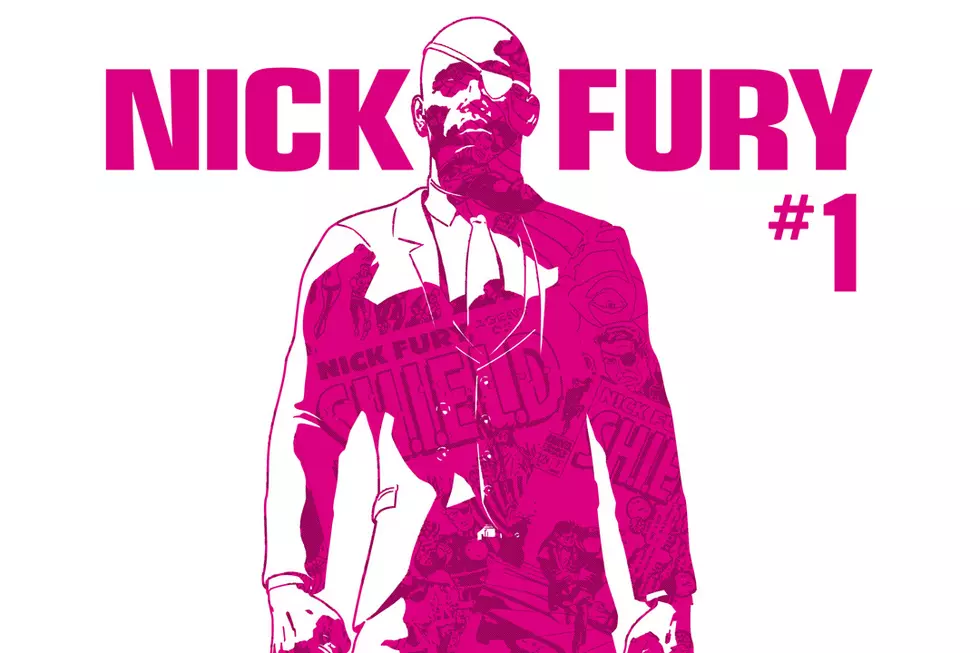
The Impossible Man: Celebrating the Extraordinary Life and Career of Jim Steranko
Of all the artists who've made a permanent impact on comics, Jim Steranko did so the quickest, solving the puzzle in the fewest moves. Born on this day in 1938, he's had many occupations --- artist, writer, magician, escapologist, musician, designer, publisher, scholar, innovator, raconteur, living legend, and Twitter celebrity. His life and art are so singular that only one word seems to describe him: Steranko.
By now, it seems like everybody should know Steranko's story innately, like ancestral knowledge passing through generations of readers. There are scores of comics masters with interesting lives, but none so fascinating and improbable as his, and the more one learns about him, the more he seems like a character sprung from one of his own creations; rendered in flesh but still wet with fiction, just barely real. His art and his legend are impossible to discuss individually; they are permanently entwined.
Born into a hardscrabble coal mining family in Appalachian Pennsylvania, Steranko was a keen self-educator from an early age, teaching himself to draw, and also teaching himself card tricks, close-up magic, and even lock-picking. Like all kids raised in poverty, his paramount lessons were likely in the tenuous art of survival; how to make it in a world that he knew didn't care for him. Perhaps it was that overwhelming necessity that inspired his unbound imagination, his self-assured determination, and the panoply of experiences that comprise his unlikely, protean life.
He performed in circuses before he hit his teens, starting as a magician, and matriculating to fire-eating and escape artistry. In his later teens, he made a living as a thief, utilizing his experience as an escapologist for safecracking and breaking-and-entering. He sang and played guitar --- again, self-taught --- in the primordial days of rock and roll, sharing stages with the likes of Bill Haley and The Comets, and even claims to have originated the idea of the Go-Go dancer. And somehow, in-between beds of nails, rockabilly riffs, and escapes from jail --- in an arranged publicity stunt, not during his time as a juvenile delinquent --- Steranko found success as a commercial artist.
He wrote and illustrated a book on close-up magic, Steranko On Cards, and contributed to Genii, a renowned magic magazine; he worked for a printing company for several years, and eventually got a nice job in advertising. He had no family to support and nothing whatsoever to lose, and when he properly entered the field, he did so under entirely different circumstances to the men who had started comicbooks a generation earlier. For Steranko, comics wasn't about necessity; it was purely another form of artistic expression.
After a short stint with Joe Simon's Harvey Comics and Tower Comics, Steranko entered Marvel's offices in 1966 --- visiting Archie, DC, and Paramount Animation the same day --- and left with an assignment, the 'Nick Fury, Agent of SHIELD' feature in Strange Tales.
Like many in the Marvel bullpen, he was at first finishing Jack Kirby's layouts of Stan Lee's plots, and the results in those earliest issues showed promise, but lacked brilliance. In a very short time, though, Steranko engineered a complete and completely unprecedented takeover, which breathed new life into both the character and the medium.
After he made it clear to Lee that the book would be better without Kirby's layouts, Steranko took over all penciling duties, and the change was dramatic. The comic took on an immediately sexier, more experimental design; sleek, full-page compositions that took greater liberties with the dissection of time.
Like Alex Toth or Bernard Krigstein, Steranko understood the temporal possibilities inherent in the comic page, and experimented with them in ways Kirby simply did not. He quickly sloughed off Lee as a writer too, soon taking over full scripting and art duties, completely unheard of at the time.
Once in control, Steranko evolved and innovated at an alarming rate. He appropriated concepts from pop art and commercial design, particularly op art, a high-contrast style of optical illusion that added new textures to the printed page. He translated cinematic effects that evoked everything from detective noir to the French New Wave. He perfected the collages that Kirby experimented with in Fantastic Four. He infused his art with elements of surrealism and psychedelic art, with pages that owed almost as much to Salvador Dali, Wes Wilson and Peter Max as Wally Wood, Will Eisner, and Alex Raymond.
Steranko synthesized styles and genres, using Nick Fury --- who came to look quite like the artist himself --- to explore superheroes and super-spies, horror stories and far-out science fiction. His work exuded sex and style, and excelled at moments of grace and silence without sacrificing raw power.
With Nick Fury, Agent of SHIELD, Steranko revealed a panorama of exciting new possibilities for the medium that was almost impossible to match. He followed that up with three issues of Captain America that were just as ingenious visually, but bogged down by Lee's clunky exposition and an overabundance of disruptive word-balloons. He provided the interiors for two issues of X-Men that he admitted his heart was never really into, but made a lasting contribution on the covers, where he redesigned the logo to the dashing piece of two-point perspective that we all know today.
His final two stories for the publisher were in the horror and romance genres, each achingly superb --- but a mere four years after he'd entered comicbooks, he made his escape. Like James Dean, who altered an American generation's concept of cool with only three films, Steranko defined cool for an entire medium in less than thirty issues.
Steranko has remained in the comics world since, but tangentially, his contributions scattershot. There's the illustrated novel Chandler: Red Tide, which Steranko claims is the first graphic novel, but that's debatable.; his superb adaptation of the Sean Connery film Outland for Heavy Metal; and his New Wave sci-fi take on the Man of Steel in the landmark Superman #400.
Characteristically, though, Steranko moved on to new challenges and thrived. He wrote Steranko's History of Comics, perhaps the first long-form work of comics scholarship. He edited and published magazines, painted book covers and posters, and worked in film, where his most enduring contribution was designing the iconic look of Indiana Jones. He continues to dip his toes into comics for covers and pinups, and occasionally teases the possibility of new interior work, but at this point it seems almost impossible.
But this is Steranko we're talking about. He specializes in the impossible.
More From ComicsAlliance


![The Odds Are Stacked And The Stakes Are High In ‘Nick Fury’ #1 [Preview]](http://townsquare.media/site/622/files/2017/03/Nick_Fury_1_Featured.png?w=980&q=75)






